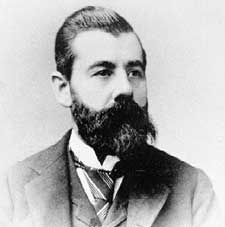John Kruesi
- Birthdate
- 1843/05/15
- Birthplace
- Switzerland
- Death date
- 1899/02/22
- Fields of study
- Machining
Biography
Thomas Edison may get most of the credit for his inventions, but his workforce certainly had a hand in Edison’s success. One of the most valuable to Edison was machinist John Kruesi.
A machinist uses “machine tools” to make things. Machine tools are “machines to make machines.” They are usually machines that are capable of shaping metal—not bending or hammering it, but rather carving it or grinding it to very exact shapes. Usually one has to use several different machine tools to make a complex metal part—one type of machine to drill holes, another to cut flat surfaces, another to cut curved surfaces, etc. Machinists are distinguished from mechanics, who repair machines; engineers, who design machines; and draftsmen, who transfer the ideas of engineers to paper so that machinists can make them on machine tools. As Edison’s machinist, Krusei worked on some of the great inventor's most important inventions.
Kruesi was born in Switzerland in 1843 and was trained as a clockmaker and instrument builder. In his younger days, he worked in Zurich, Switzerland and Paris, France before coming to the United States and settling in Newark, New Jersey. While in Newark he met Edison, who gave him a job at his Newark shop in 1872. Edison observed Kruesi’s talent as a machinist and made him the manager of the machine job. This entailed overseeing the construction of test models for the inventor’s experiments. Often, Edison gave Kruesi a simplified drawing of what he wanted him to construct. They talked about what needed to be done, of course, but they had worked together so closely and for so long, and Kruesi was such a talented machinist, that Edison could trust him to finish any unspecified design.
As Edison moved on to his electric lighting project in the late 1870s, Kruesi moved with him. Edison placed Kruesi in charge of the experimental machine shop at Menlo Park, where he made significant contributions to Edison’s lighting system. When Edison introduced the system commercially, Kruesi managed the shop that manufactured underground wires in insulated metal tubing tubes and oversaw their installation for the first New York central station. The tubing company was later absorbed into the Edison Machine Works, and Kruesi served as Assistant General Manager under another long-time Edison employee, Charles Batchelor. In 1886 Batchelor took another position, and Kruesi became General Manager.
People other than Thomas Edison eventually controlled Edison General Electric, which manufactured the Edison lighting system after about 1889. The machine works was moved to Schenectady, New York that year and Kruesi followed along and became Assistant General Manager. Over the next six years the workforce under Kruesi grew from 200 to over 4000 people. When the company merged with several others to form General Electric Company in 1892, Kruesi was promoted to General Manager, and then to Chief Mechanical Engineer in 1896. However, just a few years later he died in 1899 at the age of 56.
